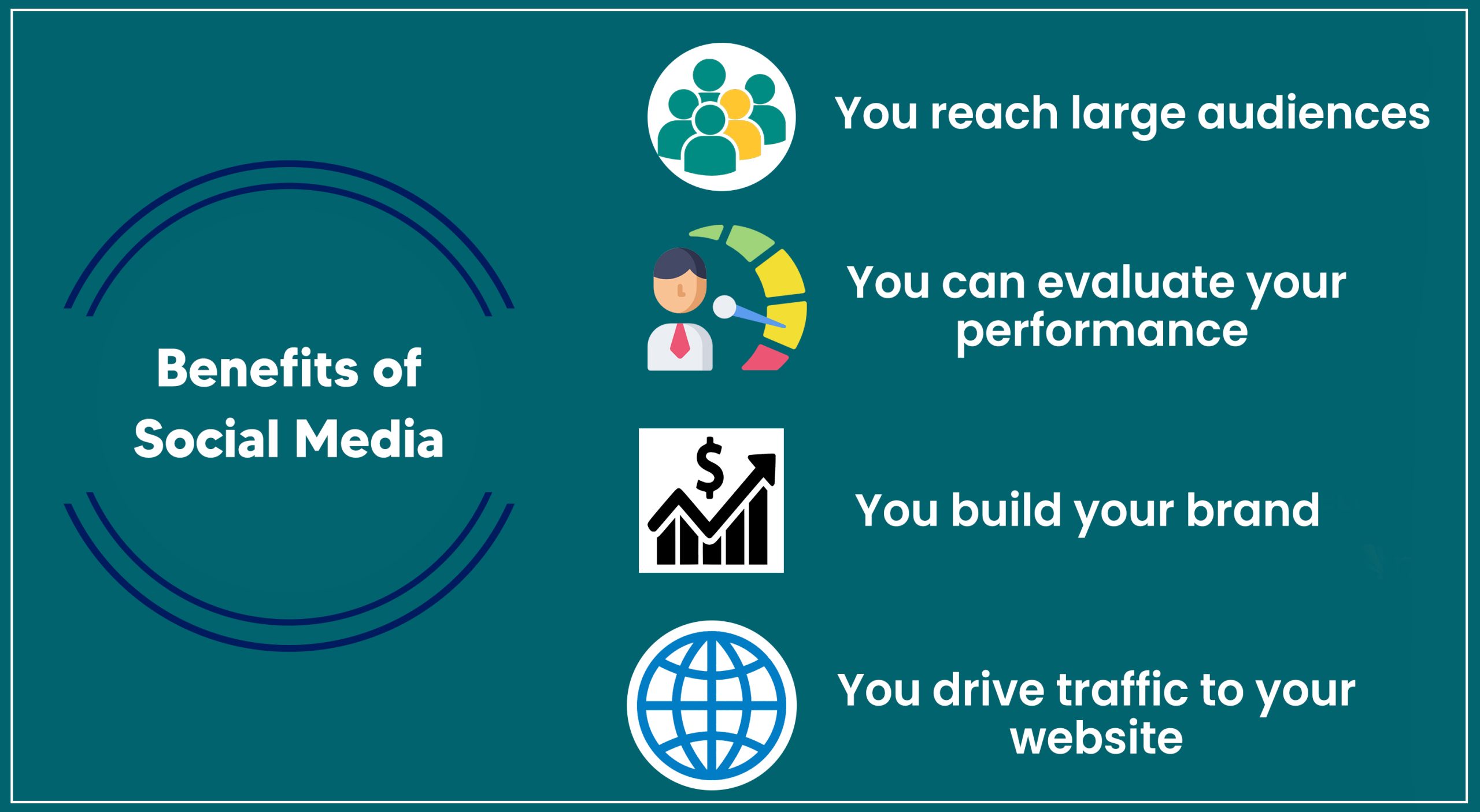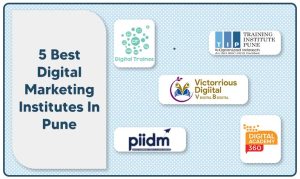Social media offers a linking and communicative platform to individuals and brands, adding new aspects of transparency to the interaction between the company and customers. Most people follow and engage with the brands on social media. Thus, people are more likely to purchase through social media from the brands they follow, especially Facebook and Instagram.

Though it can sound difficult to deal with, its significance cannot be overstated. It is critical that 97% of advertisers use social media and 78% of salespeople outsell their rivals by using social media for their companies.
In addition, the advantages reach well beyond growing revenue.
However, not all organizations know the value of social media marketing. In reality, 50% of small companies do not use social media to advertise their businesses. This is an alarming figure. More notably, 25% do not intend to use social media in the future either.
Let us look at the different ways social media can assist you in linking, interacting, and improving your brand. We’ll discuss the benefits of social media.
1. Connect with Customers

The Internet has bridged the conventional contact gaps between individuals and brands, and social media is a powerful tool for businesses to connect with their audience. With 74% of people following social-media brands and 96% of people interacting with brands on social media, it’s clear that social media is a platform where customers feel empowered to approach a brand with feedback, questions, and complaints. It also provides businesses with the opportunity to keep their audience updated about new products or services, and to display their brand’s further dimensions.
Companies can connect in various ways with customers. Towards the importance of sincere engagement with consumers, sponsored posts and targeted ads can be a perfect means of turning followers into consumers. More and more users have begun to connect on websites like Facebook, Twitter, Pinterest, Instagram, and more to advertise their favourite brands on these channels. This helps the corporation become more exposed to their clients, requirements, and frustration. By identifying dissatisfied consumers early on and taking action accordingly, companies may get more information about optimizing their products.
In a nutshell
- 74% of people follow brands on social media, and 96% interact with brands.
- Customers use social media to provide feedback, ask questions, and voice complaints.Social media helps businesses keep audiences updated about new products and services.
- Companies can engage sincerely with consumers through posts, ads, and direct interactions.
- Social media users often promote their favorite brands, enhancing brand exposure.
- Early identification of dissatisfied customers helps optimize products and services.
- Valuing consumer feedback helps businesses stay ahead of competitors.
2. Increased Brand Awareness

Brand awareness, the degree to which someone may remember or understand a brand, is a crucial aspect of marketing. Brands with a strong market image are most brought up in dialogue and are critical players in the decision-making process. This alone underscores the value of brand awareness and the important role that each individual plays in the marketing process.
We live in the age of social media marketing, and any company understands social media’s value. Social media has proved to be a critical factor in building brand recognition if you’re using influencers, referrals, or just putting out positive content yourself. This is because social media is a perfect outlet for marketers to retain client relationships while at the same time being offered the chance to discover potential leads. Many people hear about new brands because a friend has listed them on social media.
The reality is that there are many ways to use social media to create brand recognition. And the best thing is, if you like, you can explore any of them. Here are a few ways through which social media can boost your brand awareness.
a. Promote your Content
You may have seen your favourite brands post their ads on their social networks. Many companies want to use this room to push their blogs, videos, and other material they’ve worked hard on. This is simply that their follow-up is likely to be people who are interested in what they have to suggest, not to mention that they will find it helpful. By posting information, you also make it easy for users to see, search and download it.
b. Increase your Engagement
Social sites are not just platforms for communication, they are playgrounds where people can engage with each other. This makes it a perfect opportunity for businesses to connect with consumers at any point in their journey, whether they’re potential customers, existing clients, or people you’re trying to re-engage with. The power of social media in increasing engagement offers the potential for meaningful interactions.
3. Better Audience Targeting

If you’re running a company and want to attract more customers in your target demographic, how much have you put into a social media marketing strategy? Social networking is no longer simply a means for people to connect with loved ones; it is now becoming mainstream for companies to boost interaction, improve brand awareness, and expand further.
Social media is very effective for business campaigns, and many people use them. Statista reports that there are 2.7 billion social media users worldwide, which is growing yearly. It doesn’t go anywhere and will continue to be a resource for marketers to expand their audiences and hit their target markets.
Let’s look at a few ways you can use social media to make your target audience more available.
a. Make use of trending industry hashtags
The use of hashtags has spread through social media in the last decade. It’s a convenient and quick way to remain updated on new trends, fashion discussions, and business concerns. You are still good at getting your material out to a wider audience through your social media messages. Anyone who searches this hashtag will see content that will help to expose your brand.
b. Use data to analyze your target market
It would be challenging to meet your target demographic if you weren’t sure who they were in the first place. Playing a guessing game is not good enough; you need to provide evidence to make educated decisions about your company and know exactly who you’re catering to. Otherwise, you’re going to spend time, effort, and marketing capital on the wrong group of people with little or no success to show for it.
Instead, use your website and social media analytics to identify and describe your target demographic. This data will tell you the demographics of your customers, what content they consume the most, and when they are most involved. Google Analytics is the best bet for narrowing down your target market.
4. Less costly than traditional media
Marketing in social media is much less costly. You’ll cost a fraction of the conventional media price to reach the same number of viewers or more to reach the demographic you desire. And we’ve got the numbers to prove it. The cost-per-thousand impressions measure used in this calculation is (CPM). The CPM for social media is less than $3. Radio drops in at about $10, and (a great surprise) the CPM for TV is a massive $28.
Switching from conventional media to social media can be one of the most powerful things you decide to do with your business. Social networking offers you multiple ways to sell products effectively and efficiently. You will find that you need a full-scale Facebook advertising plan that is applied, consistently checked, and perfected. You could be ready for expert content marketing.
Customer service and customer support
Social media customer service and customer support to offer assistance across social networks such as Facebook and Twitter. It lets companies reach consumers where they are and answer their questions easily. About 60 percent of consumers agree that a simple solution to the problem is the most critical aspect of good service. That alone makes social media customer support indispensable because it’s another near-instant talk site.
Social media networks have become more than advertisement and advertising platforms. Nowadays, they are also legitimate and essential channels for customers to get customer service, particularly with the conversational industry’s rise. For the interaction to happen, your help staff must be available on your consumers’ preferred channels. For most businesses, this includes Facebook, Instagram, Twitter, and LinkedIn. You could also have clients using Pinterest, Youtube, and Snapchat.
Build Online Reputation
Social media plays a pivotal role in how other people view your company as one of your online reputation’s main suppliers. From creating relationships through direct contact with your fans to building a clear brand picture for your company, social media helps link businesses with millions of people every month.
Building a long-term online reputation has become an important aspect of doing business online. In the face of the digital revolution, when you can effectively handle your online identity and social media visibility, you can increase your growth and potential set. With an authentic and representative digital footprint, the company will play its part and capitalize on successful public relations.
A strong online reputation also has a long-term effect on revenue and earnings. Statistics also show that people value online feedback: 90% of survey respondents said that favorable online reviews affected purchase decisions. By contrast, 86 percent said that purchase choices were affected by unfavorable online feedback.
Benefit for Business
1. Increase In Website Traffic
Traffic has long been known to be one of the key rating considerations. Social networking impacts the traffic to your blog by making your posts more accessible. When many users spread your content through their networks, they can bring more traffic to your website and thereby raise your rankings.
A case study showed that their rating for the word “Google Images” rose from 74th to 8th in just one day. This sudden growth in rating happened only after the company had 20,000 unique users from Reddit.
2. Easy lead generation
The generation of social media is part of every marketer’s strategy—whether they know it or not. For advertisers willing to go beyond brand awareness and interaction, social media leaders’ generation is a successful next step. Collecting social media leads will help you identify people who are involved in your brand. More specifically, these leads will help you keep in contact with future customers—whether to make a promotional deal or sharing news. In fact, most marketers believe that social media marketing is the path forward for improving lead quality.
3. Partner with influencers
Influencer marketing is a technique that companies use to advertise their goods and services through relationships with prominent social media users or bloggers. Influencers typically have a large, committed following that advertisers can exploit to create awareness and even boost sales.
The influencers you see on social media have a couple hundred thousand or more than a million followers on Instagram or Snapchat, or YouTube. These people have built up their well-earned fans, which is why they are considered influencers. Bear in mind that creating a follower is very difficult. YouTube and Facebook pay these people a great deal of money because they have this massive organic traffic.
4. Go viral overnight
Viral marketing is a technique that results in the rapid dissemination of a commercial advertisement online. Viral marketing uses existing sales platforms as a corporate tool to advertise a product, service, or brand. The practice is associated with the virus’s action, sharing from one human to the next, instantly captivating a large crowd, either at one place or internationally.
5. Special Announcement in time of Crisis
In recent social crises, such as the outbreak of coronavirus disease in 2019, the conflict between formal ‘command and control’ and informal social media has caused self-organizing information and contact networks used for crisis management decision-making. Distrust of social media impacts the distribution of crisis information as it causes shifts in media understanding and engagement and improvements in the way people and institutions use information in sensitive circumstances.
6. Keep an eye on your competitor
Social media networks present brands with many ways to advance their market interests, often focusing on improving customer relationships; moreover, social media is also a fantastic way to track your rivals quickly. Knowing how you match up against your rivals will give insight into how and brand is viewed and who has the strongest voice and presence on social media.
Discover Insights regarding your business
Social media is meant to be the best friend of a corporation. Although stakeholders’ voice always incorporates constructive and alternative viewpoints, the content always provides useful feedback that helps lead and direct future progress at all shop, division, and corporate and shareholder levels. With business data curated from social media, businesses can easily imagine, interpret, and consider what is being shared about brands and products and use the knowledge to help understand consumers and markets, strengthen decision-making and potentially maximize profitability.
Conclusion
Social media is a vital part of corporate marketing, but it doesn’t have to be stressful to handle. Taking the first step, build a profile, and begin to connect with your customers with the help of a digital marketing agency can be a prominent solution.
As it begins to weave into our lives’ day-to-day routines, more customers will turn to new and evolving media for buying decisions. Those with a good social media presence and branding would boost conversion rates, whereas those without aggressive social media campaigns will lose potential buyers. Which business would you like to be?



